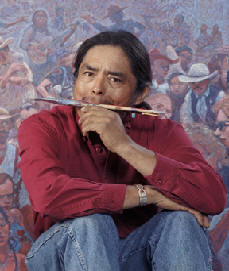It has been over 10 years since I created a stir in my community with my art. I want to revisit this tempest not out of any residual angst, but to further educate the viewing public.
Fortunately for me, most of my viewing public is made up of sophisticated consumers. But for those not familiar with this event, here it is … again. Three months into an exhibit of my paintings at the Museum of Northern Arizona in 1998, I received a call from the newspaper informing me of a complaint lodged by a local mother, who was concerned that her grade school daughter(s) were about to view my show, which, the mother contended, contained pornography. The child’s teacher at Weitzel was preparing his students before they embarked on a visit to the museum when the mother somehow found out that I was peddling “improper” material for their consumption. The principal of said school accompanied the mother to the exhibit, which he deemed to be tasteful and proper. The mother was not convinced and withdrew her student(s). She believed that kids exposed to similar images grow up to be sexual predators, unwed mothers, anxiety-ridden adults and, I concluded, eventually contribute to the fall of the Western civilization.
The painting in question was “WhiteShell Woman,” a very significant figure in Dineh cultural mythology and the maternal grounding for all of our stories and identity. She is the mother of Hero Twins. “WhiteShell Woman” was one of 33 paintings I had hanging at the museum.
I explained to the newspaper exactly what the image was about. It was no different than the many great icons of the world—the Madonna and child, and the pained crucifixion to name but two. “WhiteShell Woman” is a view into our Dineh esotericism minus the redundant sheep camp and stoic Indian scene. It is an important painting. It is a painting I executed with the help of the students at Monument Valley High School as an exercise in connecting their past, their stories and their place in the world. It is an art piece that created no discomfort out on the Rez, except for a minor local Navajo politician, whose agenda included dressing WhiteShell woman in buckskin, with trinkets and dream catcher. That went nowhere because it was stuff made of Hollywood.
In my composition, WhiteShell Woman is suspended between Heaven and Earth. The brilliant sacred Sun father is bathing her head in a glow of halo and mist from the sea, draping her midriff strategically and giving her a veil of mystery. WhiteShell Woman is unclothed; she holds the infant Hero Twins in her arms. Her right breast is tastefully exposed. She gazes reverently off to her left, chin lifted. All about her is a steady stream of my trademark neo-impressionist strokes, a thousand syllables to the ancient BeautyWay prayers. At her feet, not touching, is the symbol of the element of the east, WhiteShell. “WhiteShell Woman” stands as a painting about 6 feet tall.
The next day, the image the concerned mother did not want young people to see was on the front cover of the newspaper in full color.
The letters to the editor came in a steady stream while I just sat back and took in the whole drama. Defenders of the art and the artist were abundant and articulate. The Artist Coalition of Flagstaff was the first to give a voice of reason in the paper. Needless to say, the hoopla was an education for me as well. It brought me closer to my own world of spirituality and aesthetic, for which I am ever grateful. The public uproar lasted for several weeks and I have never felt as validated as an artist. The discussion was good for me, for the community and the world of social and creative tolerance. I put the whole thing to rest when other mainstream media beyond the Southwest wanted to get involved.
Art communicates. But sometimes the message is hard won.
“WhiteShell Woman” has been gifted to the Museum of Northern Arizona. It is currently on exhibit at the Navajo Nation Museum in Window Rock. I hope you stop by and say “Ya ateeh.”

